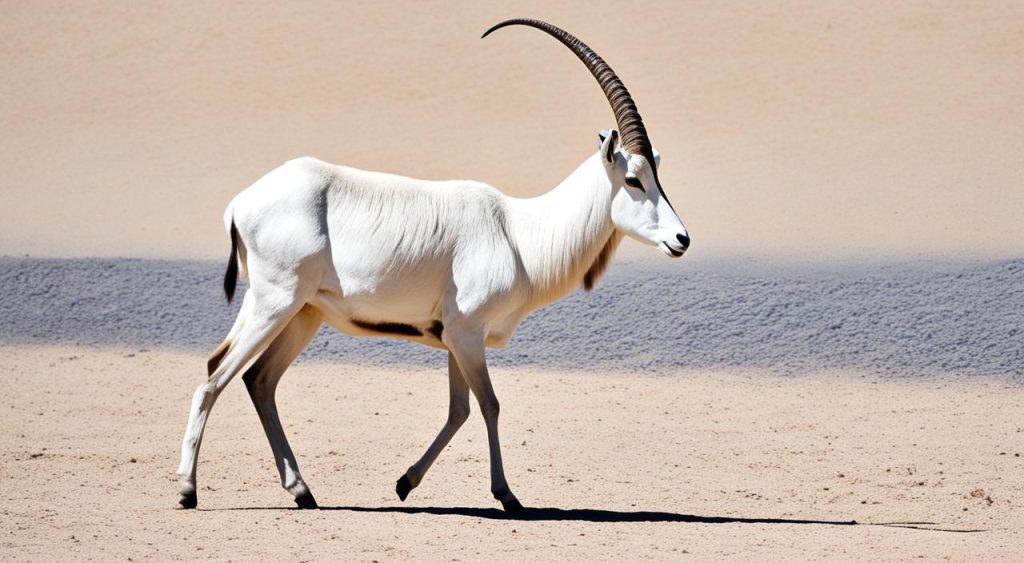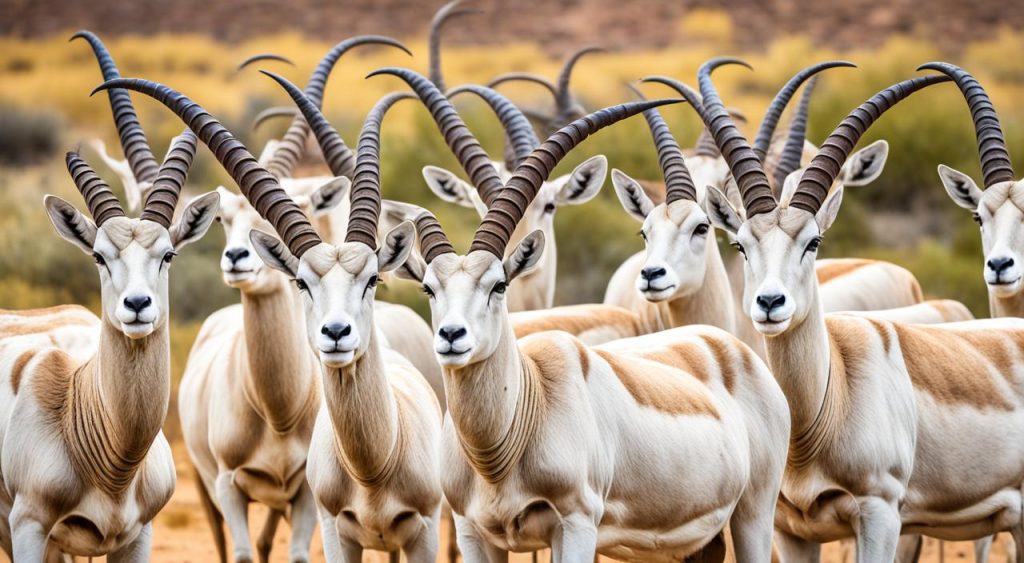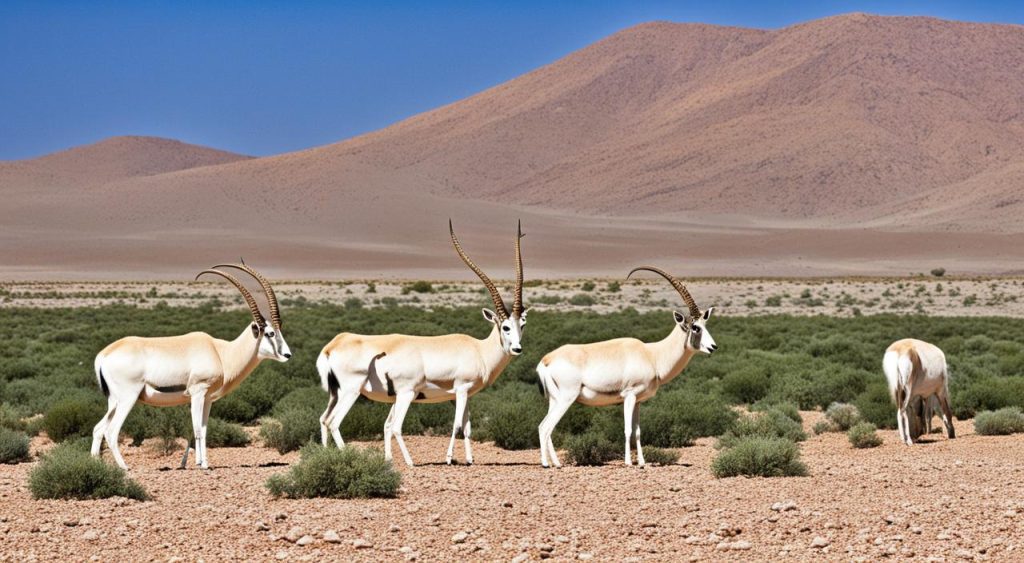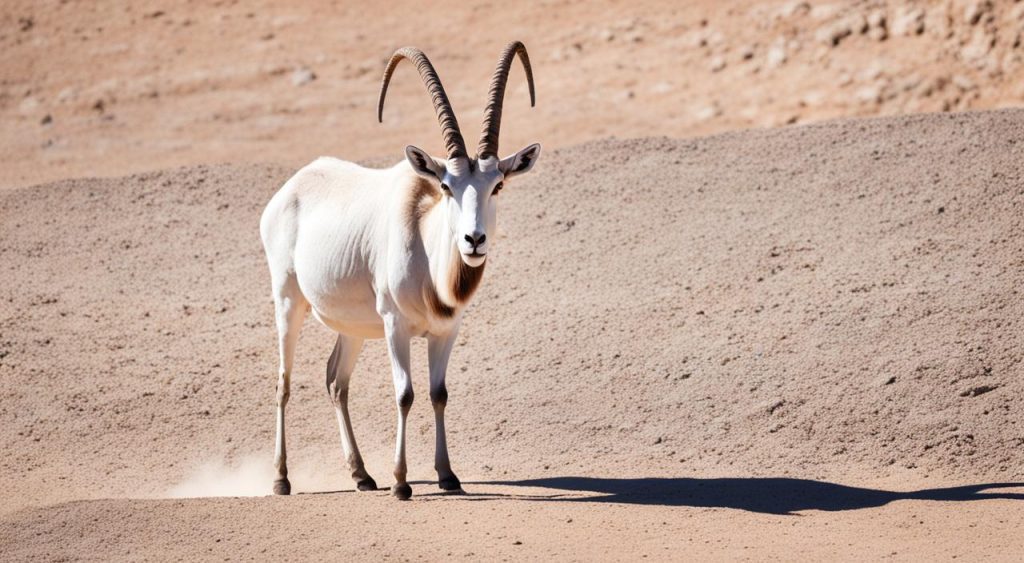The addax, a spiral-horned antelope, calls the Sahara Desert of North Africa home. Once widespread, it now inhabits only a few remote spots due to overhunting and habitat destruction. Its survival is a testament to its unique traits, such as long, twisted horns and a coat that changes with the seasons. These features help it endure the desert’s harsh conditions.
Today, the addax population barely exceeds 100 individuals, scattered across Mauritania, Niger, and Chad. The International Union for Conservation of Nature has deemed it Critically Endangered. It’s also on CITES Appendix I, highlighting the critical need for conservation. Efforts are essential to prevent this desert antelope from vanishing forever.
Introduction to the Addax: A Unique Desert Antelope
The addax stands out as a remarkable antelope species, having developed unique adaptations to survive in the Sahara desert’s harsh conditions. It is the sole member of the Addax genus, belonging to the Hippotraginae subfamily. This group is distinguished by their distinctive horns and resilience in extreme arid environments.
Throughout history, the addax has had significant interactions with humans, from ancient Egyptian art to contemporary conservation initiatives aimed at saving it from extinction. Given its endangered status and a decreasing wild population, it is vital to understand the addax’s unique traits and adaptations. This knowledge is essential for its survival in North African deserts.
The Addax: A Highly Adapted Desert Antelope
Male addax antelopes weigh between 220 to 300 pounds, with females weighing about 10-20% less. They stand between 37 to 45 inches tall at the shoulder, and their spiral horns can reach 30 to 43 inches in length.
- Addax herds range from 5 to 20 members, with the eldest female leading the group.
- These antelopes are found in the arid areas of Mauritania, Chad, and Niger, where they can survive with less than 100 mm of rainfall annually.
- Despite their rarity, the addax has a long history with humans, from ancient Egyptian depictions to modern conservation efforts aimed at preventing their extinction.

The critically endangered addax faces threats like hunting and habitat loss. Conservation initiatives, such as the Termit & Tin Toumma National Nature Reserve in Niger, are vital for its survival. These efforts aim to protect this unique desert antelope.
Physical Characteristics of the Addax
Distinctive Spiral Horns and Seasonal Coat Changes
The addax stands out as a desert antelope with unique physical traits. This species shows clear differences between males and females. Both have notable spiral horns, with females’ horns measuring 55-80 cm and males’ reaching 70-85 cm. These horns highlight the addax’s adaptation to the harsh Sahara.
Aside from their horns, the addax undergoes coat color changes with the seasons. In winter, their coat turns greyish-brown, blending with the rocky terrain. Come summer, their fur shifts to nearly white or sandy blonde, aiding in reflecting desert sunlight and controlling body temperature. This adaptation is crucial for survival in the Sahara desert.
The addax’s sturdy build and broad hooves are also key to its desert survival. From their spiral horns to their seasonal coat changes, these traits make them adept at desert life. They are true experts in adapting to the desert’s challenges.

“The addax’s distinctive physical features, from its spiral horns to its seasonal coat changes, are a testament to its remarkable adaptation to the Saharan desert.”
Habitat and Distribution of the Addax
The addax, an elusive and captivating desert antelope, inhabits the arid, sandy, and stony expanses of North Africa. Historically, it roamed from the Atlantic Ocean to the Nile River. Today, it is confined to a few remote areas within the Sahara desert, mainly in Chad, Mauritania, and Niger.
Despite its resilience and adaptations to the harsh Saharan environment, the addax’s distribution has drastically decreased due to hunting and habitat loss. In the 1960s, there were up to 5,000 individuals. By 1998, this number had plummeted to fewer than 200.
Conservation efforts have led to the reintroduction of addax to protected areas in Morocco and Tunisia, offering hope for its recovery. However, the addax’s survival remains threatened, classified as Critically Endangered by the International Union for Conservation of Nature (IUCN).

The addax’s ability to thrive in extreme environments showcases its remarkable adaptations. These desert-dwelling antelopes have evolved to survive without water, relying on specialized physiology and behaviors. Their future is uncertain, and ongoing conservation efforts are vital for their survival.
| Habitat and Distribution | Key Facts |
|---|---|
| Natural habitat: Arid, sandy, and stony deserts of North Africa Historical range: Atlantic Ocean to the Nile River Current distribution: Chad, Mauritania, Niger, and reintroduced populations in Morocco and Tunisia | Historically, addax populations were abundant, with up to 5,000 individuals in the 1960s Dramatic population decline to fewer than 200 addax in the wild by 1998 Addax classified as Critically Endangered by the IUCN Conservation efforts focus on reintroduction and habitat protection |
Addax: A Critically Endangered Species
The addax, a unique desert antelope, inhabits the arid expanses of North Africa. It is listed as critically endangered by the International Union for Conservation of Nature (IUCN). With under 100 individuals left in the wild, its population has plummeted due to severe threats.
Threats Facing the Addax Population
The main threats to the addax include unregulated hunting and habitat loss. Originally, they spanned from the Atlantic to the Nile River. Now, they are confined to isolated areas in Niger, Chad, and Mauritania.
Due to their slow pace and non-aggressive behavior, addaxes are easy prey for hunters using motorized vehicles. Habitat destruction, caused by oil drilling and agriculture, exacerbates their survival challenges.
“In 2020, the addax population in Chad grew from 15 to 50 due to a reintroduction project, offering a glimmer of hope for this critically endangered species.”
Conservation efforts are underway to protect the remaining wild addaxes and reintroduce captive-bred ones to secure habitats. These projects aim to reverse the addax’s decline and secure its future.

Adaptations for Surviving in the Sahara Desert
The addax, a rare antelope native to the Sahara Desert, has evolved remarkable adaptations to thrive in this harsh environment. Its highly reflective coat is a key feature, helping to regulate its body temperature and protect it from the intense desert heat. This trait allows the addax to conserve water by reducing the need for panting to cool down.
Moreover, the addax can extract moisture from the plants it eats, minimizing its reliance on free-standing water sources. Its dry feces and concentrated urine further highlight its exceptional water conservation abilities. These strategies enable it to survive in the Sahara’s arid conditions.
Its broad, spongy hooves are another adaptation that aids its survival. These unique feet facilitate efficient movement on the sandy terrain, making it easier for the addax to navigate the desert landscape. By combining these physical adaptations, the addax has become remarkably well-suited to the Sahara Desert’s challenges.
The addax’s ability to tolerate significant increases in body temperature before panting is a remarkable adaptation. This allows it to conserve precious water resources, a critical survival strategy in the water-scarce Sahara Desert.
These adaptations, developed over generations, have enabled the addax to thrive in the Sahara’s extreme conditions, where water is scarce. By leveraging its unique physical and physiological traits, the addax has found ways to not only survive but to flourish in this challenging environment.
Social Behavior and Herd Dynamics of Addax
The addax, a desert antelope, displays fascinating social behaviors and herd dynamics. These traits are essential for survival in the Sahara. They form herds of 5 to 20 individuals, with a clear hierarchy based on age and dominance.
Hierarchical Structure and Roles within Addax Herds
The oldest female leads the addax herd, guiding its movements and decisions. Her deep knowledge of the desert is invaluable. Males guard the females, while females establish their dominance hierarchies, often tied to age and status.
This social structure and dynamics are key to the addax’s desert survival. Together, they can find water, graze, and defend against predators. Their cooperative behavior, combined with their unique physical traits, allows them to flourish in the harsh Sahara.
“The addax’s social structure is a testament to their resilience and adaptability in the desert. By working together, these magnificent creatures can survive and even flourish in one of the most inhospitable environments on Earth.”
| Characteristic | Description |
|---|---|
| Herd Size | 5 to 20 individuals |
| Herd Leadership | Oldest female leads the herd |
| Male Behavior | Territorial, guard the females |
| Female Hierarchy | Dominance based on age and social status |
| Cooperative Behavior | Crucial for finding resources and protection |
Historical Significance and Ancient Depictions of Addax
The addax, a unique antelope species native to the North African deserts, has a long and fascinating history. It is deeply connected with human civilizations. Depictions of the addax have been found in ancient Egyptian tombs since 2500 BCE. This suggests that the ancient Egyptians may have domesticated the species. The addax might be the “pygarg” or “white-buttocked” beast mentioned in the Bible’s Book of Deuteronomy. This further highlights its cultural significance in North African societies.
The ancient Egyptians revered the addax as a symbol of abundance, prosperity, fertility, strength, and good luck. Its imagery appears in various ancient Egyptian artifacts. These include pottery, jewelry, and luxury items like watches and furniture. The addax’s distinctive spiral horns symbolize durability and elegance.
The addax’s historical importance is evident through its presence in ancient art and mythology. Despite facing extinction threats today, its symbolic meaning remains powerful. It reminds us of the balance between humanity and nature. Conservation efforts aim to protect the addax’s habitat and cultural heritage for future generations.
“The addax has inspired various symbolic interpretations and cultural depictions across many civilizations, highlighting its historical significance and enduring legacy.”
Today, the addax faces many challenges, but its rich history and ancient depictions in art and literature show its resilience. They also highlight the deep connection between humans and nature. As we work to save this endangered species, we must also respect its historical importance. This helps us learn more about our shared past.
Conservation Efforts for the Addax
The addax, a critically endangered desert antelope, teeters on the brink of extinction. Yet, through concerted conservation efforts, its survival is ensured. Today, substantial populations thrive in zoos, wildlife facilities, and private ranches globally. These are mainly in the United States, Europe, and the Middle East.
Captive Breeding Programs and Reintroduction Initiatives
Captive breeding and reintroduction programs aim to reestablish addax populations in their original habitats. This is happening in Tunisia and Morocco, among other places. These efforts are crucial for the addax’s future, as they replenish the wild with animals from captivity.
Government agencies, businesses, local communities, and NGOs collaborate on these projects. Despite the hurdles, including high costs and technical challenges, the goal remains clear: to save the addax from extinction. This commitment underscores the importance of preserving this unique species.
FAQ
What is the addax and where is it found?
The addax, a unique antelope with spiral horns, inhabits the Sahara Desert of North Africa. It’s the sole member of the Addax genus, belonging to the Hippotraginae subfamily.
What are the distinctive physical characteristics of the addax?
Distinguished by long, twisted horns and a coat that changes with the seasons, the addax is well-suited to desert life. Males outsize females, and both exhibit the iconic spiral horns.
Where does the addax live, and how has its habitat range changed over time?
Originally, the addax roamed from the Atlantic to the Nile, across arid, sandy deserts of North Africa. Now, it’s confined to a few remote Sahara regions, mainly in Chad, Mauritania, and Niger.
What is the conservation status of the addax, and what are the main threats to its survival?
The addax is critically endangered, with under 100 individuals left in the wild. Hunting and habitat loss, due to oil drilling and agriculture, pose significant threats to its survival.
How has the addax adapted to survive in the harsh Sahara Desert environment?
To endure the Sahara, the addax has developed unique adaptations. Its reflective coat, water extraction from plants, and broad hooves aid in survival under extreme conditions with scarce water.
How do addax live and interact within their herds?
Addaxes form social groups of 5 to 20, led by the eldest female. Their social hierarchy is based on age and dominance, fostering a cohesive herd structure.
What is the historical significance of the addax, and how have humans interacted with it over time?
Egyptian tombs from 2500 BCE feature addax depictions, hinting at ancient domestication attempts. The “pygarg” or “white-buttocked” beast in the Bible’s Book of Deuteronomy likely refers to the addax.
What conservation efforts are being made to protect the addax?
Efforts include maintaining addax populations in zoos and wildlife facilities worldwide. Captive breeding and reintroduction programs aim to establish new wild populations in protected areas, such as Tunisia and Morocco.




